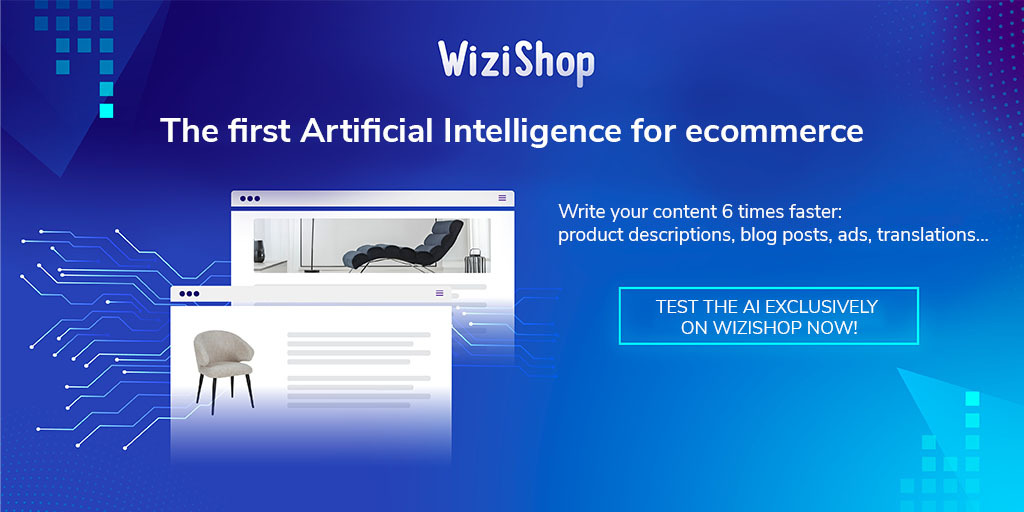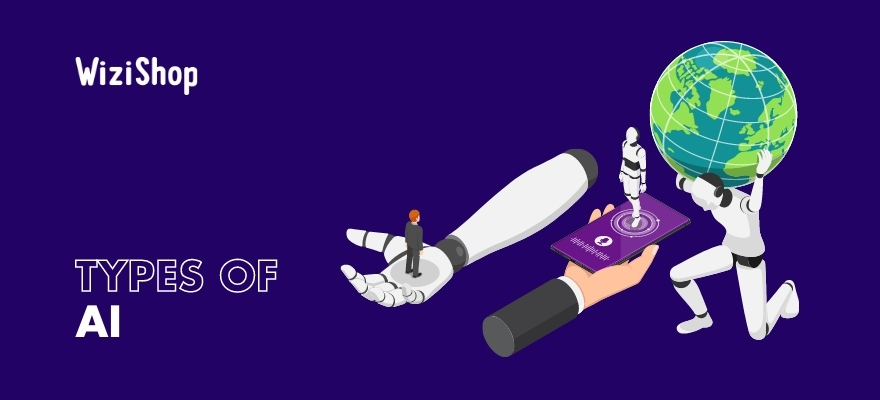The definition of artificial intelligence is simple: it involves machines and software based on algorithms to help humans in their daily lives. These robots can perform services that’ll help companies and people in their daily tasks.
Over time, the algorithms have diversified in their development: the services and applications offered by robots are increasingly complex. Artificial intelligence for language, recommendation, environmental analysis or facial recognition, etc. All our daily connected objects are equipped with artificial intelligence. Google, Spotify, Amazon, WiziShop, etc. How can we categorize the types of artificial intelligence present today? We’ll explain everything in this article!
FAQs and definition: artificial intelligence
What is artificial intelligence (AI)?
Artificial intelligence, also known by its acronym AI, defines a system or a machine that manages to imitate human intelligence in order to perform more or less complex activities, often repetitive, to help human beings in their daily lives.
Over the years, artificial intelligence has developed into machines with elaborate characteristics, and the benefits of artificial intelligence have multiplied.
What was the first AI used?
If we go back to the history of artificial intelligence, the first studies around artificial intelligence began in the 1940s in the largest universities.
Research was carried out throughout the decade until the year 1950 and the release of the first computer with a neural network, Snarc, created by two Harvard students: Marvin Minsky and Dean Edmonds. The Turing test, still used today, was created that year to analyze the capabilities and performance of intelligent systems.
From the first applications of AI theories, research has accelerated, and technologies have followed one another until today.
What are the fields of application of AI?
- AI
AI is considered to be the largest field of application: it’s the starting point of the process of this model. Basically, artificial intelligence is built on the ability of the machine to perform repetitive and simple tasks.
Today, artificial intelligence is the broad category that contains all technologies that are similar to the intelligent machine.
- Machine learning
Machine learning is an evolution of artificial intelligence based on machine learning. Where artificial intelligence is only able to reproduce repetitive tasks based on the initial configurations of its software, machine learning is able to learn thanks to the massive data collected, in order to refine its answers and its fields of competence.
This model is based on learning algorithms. The more data the machine collects, the more precise its use will be. This kind of technology is massively present around us, whether on social networks or on streaming platforms, with the aim of offering the user an optimal experience using the highlighting of content that might appeal to them based on their history.
- Deep learning
Deep learning goes even further in machine learning. This deep learning makes it possible to go even further in artificial intelligence because the machine is able to analyze concepts with more precision. Its understanding isn’t linear: the machine is equipped with a neural network built in successive layers of data.
By crossing all the data of its successive layers, the machine combines the knowledge to be able to propose a very precise answer to the user. Its mode of operation allows it to analyze data at a high level of abstraction. This technology is present in facial recognition, for example, or in very successful artificial intelligence software such as Alphago, the Google software that beat the Go world champion before beating itself.
What are the three different types of artificial intelligence?
Artificial narrow intelligence (ANI)
Artificial narrow intelligence, also known as narrow AI or weak AI, represents the artificial intelligence we know today. This model is created for a single purpose, to be able to perform single actions. Even though the technologies are very intelligent, such as facial recognition or internet search, the related model is only programmed to perform a specific category of actions.
These machines are made up of restricted configurations, with limitations, which is why they’re called weak AI. It’s assumed that systems using ANI won’t reproduce human intelligence, but will only imitate it.
Artificial general intelligence (AGI)
Artificial general intelligence, also called general AI or deep or strong AI, is a concept of a system that could imitate human intelligence and reproduce human thinking and behavior. In this way, the machine would be able to act on an idea that it had previously understood and analyzed precisely.
At this time, AGI is only at the conceptual stage, as scientists haven’t yet succeeded in the development of this kind of machine. In order to achieve general AI technology, scientists must create software to transform the machine into a conscious object through complex cognitive networks. Today, systems are good at learning, through human configurations set up front; here, the machine could be good at learning from experience, which would change its fields of competence. With strong AI, the goal is no longer to really imitate the human brain, but to understand it and recreate it in an artificial way.
The research in this AI is limited, because as the human brain is the basic model of this software and we don’t have the total knowledge of human cognitive capacities, it’s difficult today to recreate a machine in the image of an organ of which we don’t know all the contours. However, in the years to come, this technology will be developed on the basis of our ability to see and act.
Artificial superintelligence (ASI)
Artificial superintelligence is today only at the stage of utopia. This technology is mostly in the realm of science fiction: machines won’t be the equal of humans, but far superior to their knowledge and skills.
The machine would then become better than humans, whether in its knowledge or even its physical abilities. This vision of artificial intelligence has been feeding culture for many years: whether in movies or in books, ASI incites many passions. However, while the idea of artificial intelligence so gifted in everything can be attractive for many optimists, pessimists see in this concept a consequent number of unknown parameters and a danger for the survival of humankind.
What are the four largest families of artificial intelligence?
Reactive machines, the first example of artificial intelligence
We speak of reactive machines as the first steps of artificial intelligence. Their functionalities are not based on memory but on a configuration of repetitive actions. At this level, these examples of artificial intelligence don’t have the power to learn but only to imitate certain faculties of the human mind. They’re machines that can only respond to certain solicitations within a restricted perimeter and with a minimum of data.
It’s from this type of artificial intelligence that all the others were founded. In the history of artificial intelligence, the best example of a machine is the Deep Blue machine created by IBM: the software was the first to beat the chess master Garry Kasparov in 1997.
Even though its processor was very successful in its field of activity, it wasn’t created with the ability to learn and only brilliantly repeated actions for which it was configured.
Limited memory machines, learning neural networks
This AI system is based on reactive machines, but with a memory system that allows the object to learn and make decisions accordingly. These machines are therefore equipped with a limited memory consisting of a history of data. With the help of the very large volumes of data analyzed, these programs are able to integrate several types of responses and applications.
It’s the memory that makes all the difference. Within this family of artificial intelligence, we can count image recognition: thanks to all the information stored in its memory, artificial intelligence is able to name objects and recognize them in an image it analyzes.
This model can be found in our daily life and allows us to go further in our tasks, either personally or in a business.
This kind of system is present in artificial intelligence of language, such as automatic text writing. A real marketing weapon for online companies, text processing has never been so easy: translation, generation of entire articles by artificial intelligence, texts directly optimized for SEO...
This revolutionary tool is beneficial for all web entrepreneurs, especially those who have an ecommerce business: the WiziShop solution integrates its own artificial intelligence for automatic text writing within its back office and online subscriptions.

With this powerful feature, merchants can generate product descriptions and texts like blog posts directly optimized for SEO. By filling in a few instructions and parameters, the artificial intelligence creates a product description, a blog article, ad copy, etc. of a very high editorial quality that’s already optimized for SEO in a few seconds to help make the content creation aspect of an ecommerce business easier. In addition, WiziShop is free for 7 days, giving you time to test the AI and the rest of the solution and be enticed by the future of ecommerce!
Try WiziShop free for 7 days
THE EASIEST NO-CODE ECOMMERCE SOLUTION✅ No credit card required
✅ Access to all features
✅ No commitment
“Theory of mind” machines, a form of technology in the making
The types of AI we've just seen are available around us today, whether in everyday software or in processors embedded in our connected objects. Machines in the "theory of mind" category aren’t yet on the market. This sector is therefore empty of any example of machine. Nevertheless, it remains at the heart of the research and goals of researchers and engineers.
“Theory of mind" machines would therefore be those capable of having a thought process linked to that of people, a neural network that would allow them to have feelings, innovative ideas, or to be able to make decisions. They would therefore be the equal of human beings with the same level of understanding and action.
Self-aware machines, virtual intelligence at the human level
Self-aware machine systems are models that would surpass humans: with the amount of information, their data processing and their degree of analysis, these robots could therefore surpass people, to be superior to them, whether in their way of thinking or in their actions.
Although the machine wouldn’t have the same finesse of humans to experience feelings and to express the same reasoning, the machine would be aware of itself and could manage itself in total autonomy. These systems join artificial superintelligence. This category raises ethical questions in the minds of researchers and scientists, as well as in works of science fiction and in the collective imagination. For the moment, this form of artificial intelligence only exists in bookstores and on the small and big screens.










